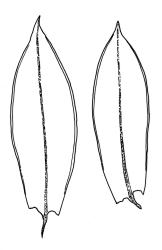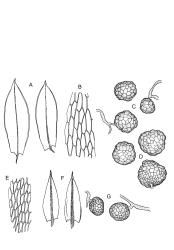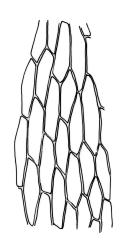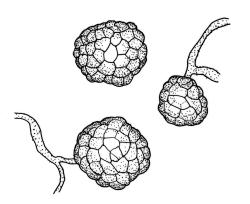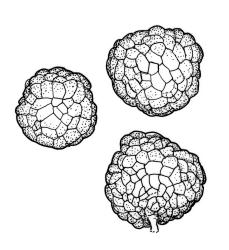- ≡ Gemmabryum rubens (Mitt.) J.R.Spence & H.P.Ramsay, Phytologia 87: 68 (2005)
- ≡ Rosulabryum rubens (Mitt.) J.R.Spence, Novon 19: 399 (2009)
Stems to c. 12 mm, beset with pale brown rhizoids (some arising in leaf axils of lower stem). Leaves evenly spaced on stem, erect-spreading moist, becoming more erect and narrowed when dry, ovate- or elliptic-lanceolate, acute, entire or weakly denticulate above, narrowly bordered and ± recurved at margins, not decurrent, c. 1.5–2.4 × 0.5 mm, with lamina forming c. 0.9 of entire length; mid laminal cells thin-walled, 69–105 × 14–18 µm; marginal cells elongate in 2–4 rows, forming a distinct border. Costa rather thin, excurrent. Tubers numerous, at least some on axillary rhizoids, spherical, 165–225(–285) µm diam., red-brown, c. 8–10 cells across, with cells moderately protruding.
Dioicous. Perichaetial leaves larger than vegetative, oblong-lanceolate, to c. 3 mm. Perigonia and sporophytes not seen.
Crundwell & Nyholm 1964, fig. 9 a–m; Smith 2004, fig. 192; Porley 2008, p. 62 & 64.
K (Raoul I., between Low Flat & Fishing Rock); NI: N Auckland (Point England Domain); SI: Nelson ("Neudorf"). All verified material is sterile.
Probably adventive. Spence & Ramsay (2006) recorded this species from mainland Australia; and scattered northern and southern hemisphere localities. According to Porley (2008), in Britain this species is characteristic of pH neutral soils.
The Raoul I. material grew in an open place among herbs at a roadside; the Point England material with Funaria hygrometrica on soil over a concrete foundation; and the "Neudorf" material on moist soil shaded by exotic weeds in a paddock. Ranging from 7 to 60 m elevation.
Bryum rubens is one of six N.Z. members of the "B. erythrocarpum complex" in the sense of Crundwell & Nyholm (1964). The complex is discussed in more detail under B. duriusculum.
The wider (relative to other species of the "B. erythrocarpum complex") and thinner-walled mid laminal cells together with the numerous red-brown tubers (with some on short, axillary rhizoids) are distinctive. The costae are also more delicate than in any other N.Z. member of the complex. The only other N.Z. species of the complex with leaves as wide as B. rubens is B. sauteri, which has very different tubers and hence is unlikely to be confused.
The Point England material accords very closely to the leaf and cell dimensions given by Crundwell & Nyholm (1964), who described the tubers of this species as "usually abundant, many of them often on very short rhizoids, clustered at the base of the stem or solitary in the leaf axils, bright crimson, sometimes darker on basic soils." N.Z. material has red-brown rather than crimson tubers.
Crundwell & Nyholm (1964, p. 633) recorded B. rubens from Napier and Dunedin. The former locality record was based on material segregated from Pottia zealandiae collected by Berggren in 1874. Two duplicates of the Berggren Napier collection have been examined but no material referable to the "B. erythrocarpum complex" is present in either. The Dunedin material that they cited is also a Berggren collection and has not been available for study.



